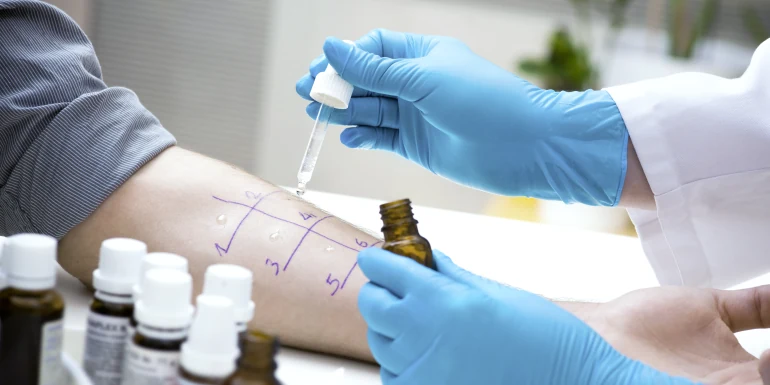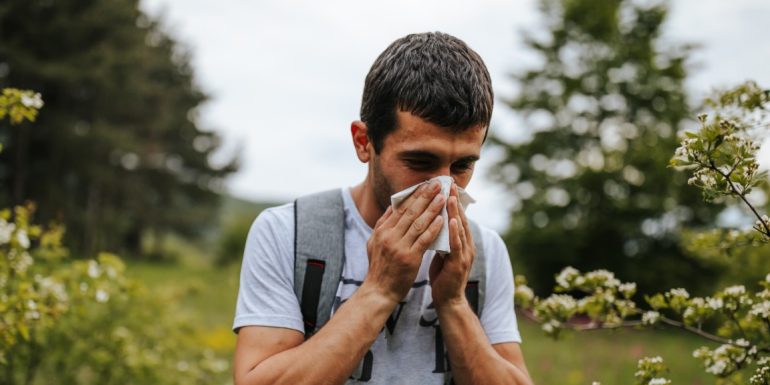
Pollen allergies: what can you do?
How can you tell if you have a pollen allergy, and what can you do about it? Are there any home remedies that help relieve hay fever symptoms such as a sore throat or a cough? Find out about hay fever and how to treat it.
What is a pollen allergy?
A pollen allergy (also called hay fever) is a common allergic reaction. Roughly 15% to 20% of the Swiss population are sufferers. The allergic reaction is triggered by the pollen of various different plants. A hay fever sufferer’s immune system overreacts to this allergen, and triggers an immune response. Since hay fever is a type I hypersensitivity, symptoms occur immediately after coming into contact with the allergen. Unlike with other allergies, such as an allergy to penicillin, a pollen allergy is seasonal. Its severity is heavily dependent on when the plants in question bloom.
A genetic predisposition is a significant factor when it comes to developing allergies, including allergies to pollen. If your parents and siblings don’t have any allergies, the chance of you developing one is between 5% and 15%. If one of your parents or a sibling is a sufferer, the risk increases to between 25% and 30%. If both of your parents have allergies, your risk of developing one yourself is between 40% and 60%. And if both parents have the same allergy, the risk is as high as 60% to 80%.
What triggers a pollen allergy?
Pollen allergies have a range of different triggers. The types of pollen that trigger allergies are from wind-pollinated plants, and are encountered at different times of the year. There are three peak times for allergy-triggering pollen:
- Tree pollen in the spring: You may be allergic to birch or hazel pollen, for example.
- Grass and cereal pollen in the early summer: People who are allergic to grass pollen often complain of a range symptoms including sniffles, itchy eyes and problems breathing.
- Weed pollen in the late summer: Ragweed and mugwort pollen can both trigger allergies, for example.
Cross-sensitivities are common in people who are allergic to pollen. They develop when the immune system is unable to differentiate between the proteins found in pollen and similar proteins in certain foods. People who are allergic to birch, hazel or alder pollen, for example, often also react to apples, nuts or carrots. Their responses can vary from mild symptoms such as itchiness in the mouth to severe allergic reactions. Those who are allergic to ash pollen, on the other hand, are less likely to develop such cross-sensitivities to food. But they may develop cross-sensitivities to olive, privet or lilac pollen, however.
Hay fever: what are the symptoms?
A pollen allergy can involve a wide range of symptoms. Typical signs include:
- Sneezing
- A blocked and/or runny nose
- Itchy, watery eyes
- Coughing and hoarseness
- Itchy gums, nose and/or ears
- Headaches and/or jaw pain
You should consult your doctor if you are affected by any of these symptoms. It’s important that you do, because an untreated allergy could develop into allergic asthma. Pollen can also cause such severe irritation that it leads to conjunctivitis.
Pollen allergies don’t normally develop until a child is kindergarten age. They are indicated by the same symptoms as hay fever in adults. There is a difference in the way that children react and deal with the symptoms, however.
You should contact a paediatrician if you suspect that your child is allergic to pollen. It is important to get a clear diagnosis so that the treatment can be tailored to your child’s condition.
Are there any tests for pollen allergies?
A pollen allergy diagnosis is an important step towards getting the right treatment. Hay fever tests that are commonly administered include:
- Blood test: A pharmacist or doctor takes a sample of blood and tests it for antibodies to certain allergens.
- Prick test: In this test, the doctor applies small amounts of various different allergens to the skin, and pricks the site gently. Redness or swelling at the site of the prick indicates an allergic reaction.
- Provocation test: The suspected allergen is applied directly to the mucous membranes to provoke a reaction. This is only done under strict medical supervision.
The doctor rules out other allergies, such as a house dust mite allergy or food allergy, when making a diagnosis.
What can you do about a pollen allergy?
There are a number of different ways to treat pollen allergies, including controlling what causes them, treating them with medication, and everyday measures.
Pollen allergies: What medications are available?
There are medications that can alleviate the symptoms of hay fever. Hay fever tablets and nasal sprays often contain antihistamines, corticosteroids, antileukotrienes or mast cell stabilisers.
You should consult your doctor before taking hay fever tablets or using other medications such as eye drops to treat hay fever.
What can I do about a pollen allergy on a day-to-day basis?
What can you do about hay fever on a day-to-day basis? Many of the steps taken to help with pollen allergies are aimed at reducing contact with pollen. This alleviates the symptoms of the allergy.
- Pollen filters: You can attach a special mesh that filters pollen to your windows. You should also check whether your car’s air conditioning system features a pollen filter.
- Indoor activities: On days when pollen levels are high, you should ideally spend your free time indoors in order to minimise your contact with allergens. If you would like to do some exercise, there are a number of different types of exercise that you can also do at home.
- Avoid certain foods: In the case of cross-sensitivities, your body also experiences an allergic reaction to certain foods. If you know what your triggers are, you should avoid them and adjust your diet accordingly.
- Pollen calendar: You can use a pollen calendar to keep an eye on pollen levels and plan your activities based on the forecast.
- Wear glasses: Sunglasses protect your eyes from pollen – particularly when you’re outside.
- Wash your hair: Wash your hair in the evening. This gets rid of the pollen that accumulates in it during the day. Pollen in your hair can aggravate your symptoms at night.
- Change your clothes: Change your clothes as soon as you get home, and don’t keep used clothes in your bedroom.
- Dry your laundry indoors: This prevents pollen from sticking to your clean laundry.
- Household remedies: Household remedies such as nasal irrigation and steam baths can alleviate the symptoms of hay fever by moisturising the mucous membranes and reducing itchiness.
Hay fever: which home remedies can help?
There are a number of different home remedies available for the treatment of hay fever by natural means:
- Butterbur (petasites hybridus): This medicinal plant alleviates the symptoms of allergies that affect the eyes, throat and mouth. Extracts from the leaves or roots of the butterbur also reduce inflammation, alleviate pain and have antispasmodic properties, which is why they are also used for conditions affecting the stomach and/or intestines.
- Eyebright (euphrasia officinalis): Eyebright is commonly available in the form of eye drops that alleviate symptoms affecting the eyes. Eyebright tea can also provide some relief from hay fever symptoms.
- Quercetin: Quercetin is found in foods including garlic, apples and onions, and has anti-inflammatory properties. It also inhibits the release of histamine, reducing the number of allergic reactions produced by the body.
- Nigella oil: According to some studies, inhaling this oil can alleviate the symptoms of hay fever.
What helps against the causes of hay fever?
In order to address the cause of a strong pollen allergy, your doctor may carry out a course of desensitisation over a number of years. In the case of hay fever, the purpose of this treatment is to change the way your immune system reacts to pollen. The treatment involves a doctor exposing your body to the allergens in a controlled environment. Increasing doses of pollen extracts are administered to your body, in the form of injections (“allergy vaccination”), lozenges or drops, in order to increase your tolerance of that pollen. Desensitisation takes about three to five years, and can reduce allergy sufferers’ reactions or even eliminate them completely in up to 80% of cases.
There are many ways to get to grips with everyday life despite suffering from a pollen allergy, without sacrificing any quality of life. Do you suffer from hay fever? Make sure to consult your doctor about what measures are available. He or she will know which treatment best suits your needs.

This specialist provided the editorial team with expert advice and input for this article. Peter Schmid-Grendelmeier is head of the allergy department of the Dermatology Clinic at the University Hospital in Zurich. He specialises in allergies of all kinds, including neurodermatitis and urticaria (hives, nettle rash), tropical and travel dermatology and histamine-mediated diseases.


Newsletter
Find out more about current health issues every month and get all the information you need about our attractive offers from all Helsana Group companies * delivered by e-mail to read whenever it suits you. Our newsletter is free of charge and you can sign up here:
We did not receive your information. Please try again later.
* The Helsana Group comprises Helsana Insurance Company Ltd, Helsana Supplementary Insurances Ltd and Helsana Accidents Ltd.